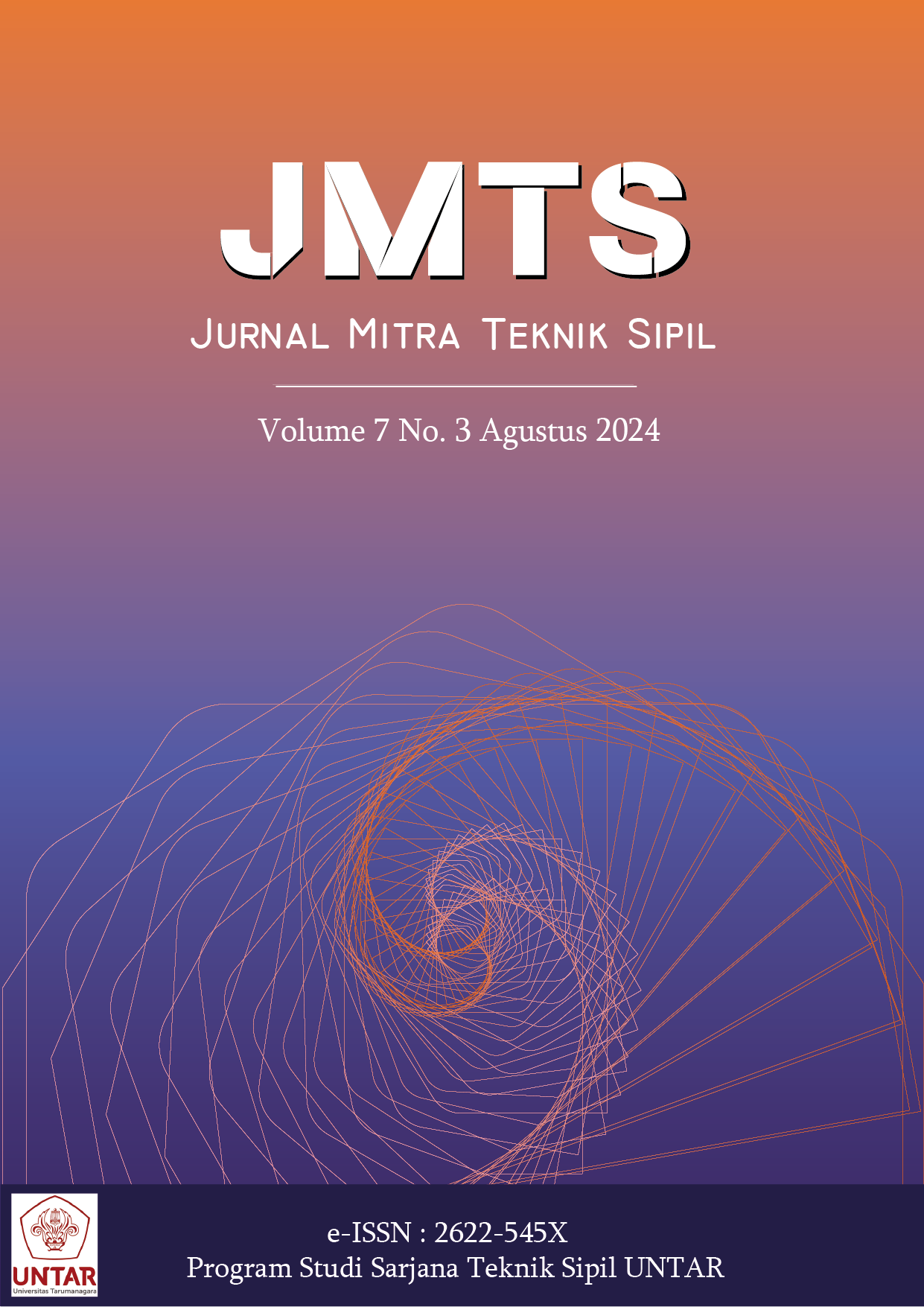ANALISIS PERFORMA BALOK T BETON BERTULANG DENGAN SERAT POLIMER MENGGUNAKAN APLIKASI MIDAS FEA NX
Main Article Content
Abstract
Over time, the structural integrity of a building may experience a decline in its capacity, necessitating the need for structural retrofitting. One method of structural retrofitting that is often used and considered ideal is to use Hybrid Fiber Reinforced Polymer (FRP) due to its ease of use and the ability to amalgamate the favorable mechanical properties of two FRP materials. This research discusses the effect of HFRP sheet composition on the performance of the flexural capacity of reinforced concrete beams. The T-beam specimens have dimensions of 260 mm in height, 155 mm in breadth, 415 mm in flange width, 60 mm flange thickness, and a span length of 2000 mm. These T-beams underwent testing with symmetric two-point loading at simple supports, reinforced with 4Ø10 tensile reinforcement, 2Ø16 compression reinforcement, and stirrups of Ø10. Flexural strengthening was carried out using 3 different HFRP compositions so that 4 test specimens were obtained including a T beam without strengthening as a control. Analysis was conducted using the finite element method through the MIDAS FEA program. The results indicate that each additional layer of HFRP significantly enhances the flexural capacity of the reinforced concrete T-beams by 97,22-145,03%. Finite element method analysis closely aligns with laboratory test results, with a maximum difference of 9% indicating that the finite element method provides a conservative approach for predicting laboratory test results.
Abstrak
Seiring berjalannya waktu, struktur dapat mengalami penurunan kapasitas struktural sehingga perkuatan struktur perlu dilakukan. Salah satu metode perkuatan struktur yang sering dipakai dan dianggap ideal adalah dengan menggunakan Hybrid Fiber Reinforced Polymer (FRP) karena mudah dalam pengaplikasiannya dan dapat memadukan sifat mekanik yang baik dari dua bahan FRP yang digunakan. Penelitian ini membahas pengaruh komposisi lembaran HFRP terhadap kinerja kapasitas lentur balok beton bertulang. Sampel balok T mempunyai tinggi 260 mm, lebar badan 155 mm, lebar sayap 415 mm, tebal sayap 60 mm, dan panjang bentang 2000 mm. Balok T diuji tersebut diuji dengan pembebanan dua titik simetris pada tumpuan sederhana dengan tulangan tarik 4Ø10, tulangan tekan 2Ø16, dan sengkang Ø10. Perkuatan lentur dilakukan dengan menggunakan 3 komposisi HFRP yang berbeda sehingga diperoleh 4 benda uji termasuk balok T tanpa perkuatan sebagai kontrol. Analisis dilakukan dengan metode elemen hingga menggunakan program MIDAS FEA dan menunjukkan bahwa setiap penambahan lapisan pelat HFRP meningkatkan kapasitas lentur balok T beton bertulang sebesar 97,22-145,03%. Hasil analisis metode elemen hingga mendekati hasil uji laboratorium dengan perbedaan terbesar 9% yang menandakan bahwa metode elemen hingga memberikan pendekatan konservatif untuk memprediksi hasil uji laboratorium.
Article Details

This work is licensed under a Creative Commons Attribution-NonCommercial-ShareAlike 4.0 International License.
This work is licensed under Jurnal Mitra Teknik Sipil (JMTS) Creative Commons Attribution-ShareAlike 4.0 International License.References
Attari, N., Amziane, S., & Chemrouk, M. (2012). Flexural Strengthening of Concrete Beams Using CFRP, GFRP, and hybrid FRP Sheets. Construction and Building Materials, 37, 746-757. https://doi.org/10.1016/j.conbuildmat.2012.07.052
Badan Standardisasi Nasional. (2021). Metode Uji Komposit Serat Berpolimer Sebagai Penulangan atau Perkuatan Struktur Beton dan Masonri (SNI 8972:2021). https://doi.org/http://sispk.bsn.go.id/SNI/DaftarList
Foster, R. M., Brindley, M., Lees, J. M., Ibell, T. J., Morley, C. T., Darby, A. P., & Evernden, M. C. (2017). Experimental Investigation of Reinforced Concrete T-Beams Strengthened in Shear with Externally Bonded CFRP Sheets. Journal of Composites for Construction, 21(2), 04016086. https://doi.org/10.1061/(ASCE)CC.1943-5614.0000743
Imran, I., & Zulkifli, E. (2019). Perencanaan Dasar Struktur Beton Bertulang (2nd ed.). Bandung: ITB Press.
Logan, D. L. (2012). A First Course in The Finite Element Method. Congage Learning.
Luastika, G. N., Lingga, A. A., & Lestyowati, Y. (2019). Perkuatan Lentur Balok Beton Bertulang dengan Glass Fiber Reinforced Polymer. Jurnal Mahasiswa Teknik Sipil Universitas Tanjungpura, 6(2), 1-7. https://doi.org/10.26418/jelast.v6i2.35569
Meikandaan, T. P., & Murthy, A. R. (2017). Flexural Behaviourof RC Beam Wrapped with GFRP Sheets. International Journal of Civil Engineering and Technology, 8(2), 452-469.
Rabinovitch, O., & Frostig, Y. (2003). Experiments and Analytical Comparison of RC Beams Strengthened with CFRP Composites. Composites: Part B, 34(8), 663-677. https://doi.org/10.1016/S1359-8368(03)00090-8
Wang, Z., Zhao, X.-L., Xian, G., Wu, G., Singh Raman, R. K., Al-Saadi, S., & Haque, A. (2017). Long-term durability of Basalt- and Glass-Fibre Reinforced Polymer (BFRP/GFRP) Bars in Seawater and Sea Sand Concrete Environment. Construction and Building Materials, 139, 467-489. https://doi.org/10.1016/j.conbuildmat.2017.02.038
Widyaningsih, E., Herbudiman, B., & Hardono, S. (2016). Kajian Eksperimental Kapasitas Sambungan Material Fiber Reinforced Polymer. Jurnal Online Institut Teknologi Nasional, 2(3), 29-38. https://doi.org/10.26760/rekaracana.v2i3.29
Zhang, P., Zhu, H., Wu, G., Meng, S., & Wu, Z. (2017). Flexural Performance of HFRP-RC Composite T-Beams with Different Interfaces. Journal of Composites for Construction, 21(3), 04016101. https://doi.org/10.1061/(ASCE)CC.1943-5614.0000757



